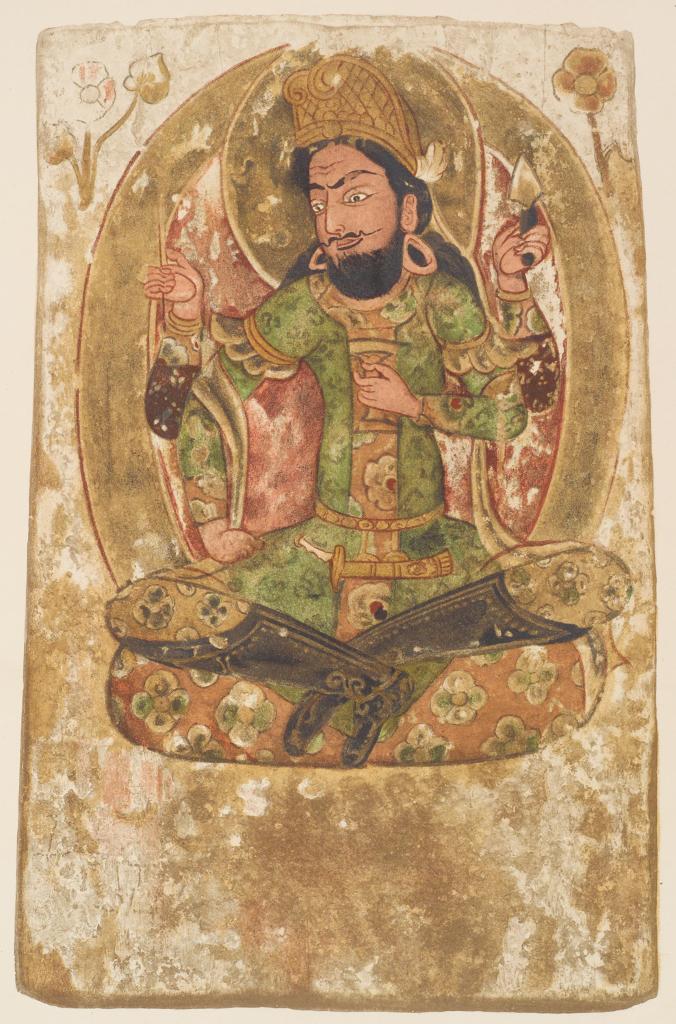|
There is nothing in the picture of the obverse that does not directly presuppose the reproduction of Indian models.
The contrast offered by the figure painted on the reverse is hence all the more striking.
Were it not for nimbus and vesica, and in particular the four arms with the emblems in some of them,
it would be difficult to believe that we have here before us the representation of a Buddhist divinity.
So completely does a quasi-secular treatment in essentially Persian style prevail in the figure and its accessories.
We see the Bodhisattva - for as such we must evidently accept this sumptuously dressed sacred personage - seated cross-legged on an
elaborately embroidered cushion.
The head, with distinctly Persian features, shows long black hair falling down to the shoulders and a thick short beard.
It is surmounted by a curious yellow head-dress, which resembles a Persian tiara with a double point falling over in spirals.
Over a close-fitting yellow undergarment decorated with large flowers the figure wears a tight coat of equally rich material in dark green.
From a narrow belt round the waist is slung a short, broad sword in an ornamented sheath.
The most curious part, however, of the attire are the high black boots exactly resembling Hessians, which reach to the knee,
and are picked out in ornamental yellow lines suggesting inlaid leather-work or stitching in gold-thread.
The scarf-like Uttarīya, which descends from the back of the head and is curled round both arms,
is the only part of the dress that the figure shares with other representations of sacred personages in these panels.
The left proper front hand holds the Vajra, while the rear one raises a spearhead; on the right proper the front hand rests on the thigh,
the one behind holding a deleted object, possibly a flower.
|
Bodhisattva on
reverse of D. VII. 6.
|
|
For the identification of this strangely attired divinity, the Vajra or mystic thunderbolt seems to afford the only clue.
It is the characteristic emblem of no less than three divinities, the Dhyāni-Bodhisattvas, Vajrapāṇi, and Vajrasattva,
as well as of the primordial Buddha Vajradhara8.
With none of the representations that I can trace of these at present does our figure fully agree;
but seeing that it shows neither the green colour prescribed for Vajrapāṇi, nor the blue one of Vajradhara,
the conjecture may be hazarded that it is perhaps meant for a form of Vajrasattva.
This Bodhisattva is ordinarily represented white, with the Vajra in one hand, and the other resting on the hip and holding the ghaṇṭā or bell9.
The latter is certainly absent in our picture, yet the general pose bears some resemblance to that of the Vajrasattva seen in the miniatures
which M. Foucher has published.
|
Identification
of Bodhisattva
on reverse.
|
The real interest of the painting lies, however, not in the eventual identification of the figure,
but in the application of a design of essentially Persian style to a subject of Buddhist mythology.
The immediate juxtaposition of this design to the wholly Indian one shown by the obverse of the same panel necessarily increases this interest.
There is nothing to suggest that the two sides of the panel were painted by different hands,
however different in origin were the models which the artist in each case followed.
The representation of a Buddhist divinity in forms derived from a non-Indian art has in itself nothing surprising, since we see the identical
process illustrated to the largest possible extent as far as classical art is concerned in the Graeco-Buddhist sculptures of Gandhāra.
But of the influence of Persian art under which Buddhist iconography may have come in those extensive parts of Eastern Iran where Buddhism
found a home and flourished, we know as yet practically nothing.
Is it possible that this curious little painting reflects features of a 'Perso-Buddhist' art such as might have developed in Balkh,
that city of many splendid Vihāras, and elsewhere within ancient Ariana?
8 Compare Foucher, Iconographie bouddhique, i. pp. 121 sqq.; Grünwedel, Mythologie, pp. 98, 141.
9 See Foucher, Iconographie bouddhique, i. p. 123, Plate VI. 5.
|
Persian style of picture.
|


